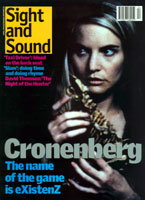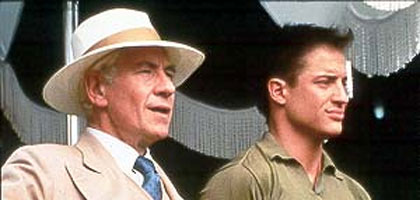
Portrait of the artist
Film of the Month: Gods and Monsters

Who created Frankenstein? "A mad scientist," says the tabloid journalist, and turns back to writing his scare piece about genetically modified 'Frankenstein foods'. "Wrong as usual," says the horror freak. "Frankenstein was the mad scientist, his poor creature went unchristened. The right answer is the man who played the brute, Boris Karloff." "A plague on both your houses," says the graduate student. "The true creator was Mary Shelley, whose book was really about womb envy." Finally, enter the unreconstructed auteurist, who regards his three forebears with an air of pitying exasperation and points out that the only correct response to the question has to be the English director James Whale.
The auteurist exaggerates but not absurdly. Although there had been nineteenth-century plays and two previous Frankenstein movies made in 1910 and 1915, it was Whale's Universal version of 1931 which finally made Mary Shelley's overdetermined yarn into a fable for twentieth-century mass culture, and it was Whale who re-invented the monster's frightful face. Where her novel spoke of a being whose "yellow skin scarcely covered the work of muscles and arteries beneath" (resembling Christopher Lee in the 1957 Hammer The Curse of Frankenstein, perhaps), Whale conceived a literal deadpan of sunken and hooded eyes, a brow like the cliffs of Dover and a prematurely fashionable flat-top. "I made drawings of [Karloff's] head," Whale explained, "adding sharp bony ridges where I imagined the skull might have been joined." Instead of looking silly, it looked like a trench hallucination (Whale had served in Flanders), or a momento mori retrieved from a nightmare.
This act of night vision ought to have been quite enough to confer deathless fame on Whale, even if he hadn't gone on to make film after distinguished film. The Bride of Frankenstein (1935) broke the iron Law of the Duff Sequel by being one of the most quirkily lyrical, gently funny movies ever made by a major studio; the musical Show Boat (1936) was greeted as a triumph; Remember Last Night? (1935) was a pioneering screwball comedy; and the Whale filmography of 20-odd completed films also includes such achievements as Journey's End (1930), Waterloo Bridge (1931), The Old Dark House (1932), The Invisible Man (1933) and The Great Garrick (1937).
In a just world, James Whale's name would be at least as well known as that of his fellow countryman Karloff, if not Hitchcock. In the real world, he has until recently been remembered mainly by the scholarly and by the sad, which is one reason for welcoming the film Gods and Monsters, a thoughtful and entertaining dramatic portrait of Whale which, despite its title, is based not on James Curtis' meticulous biography James Whale: A New World of Gods and Monsters (1998) but on Christopher Bram's more fanciful 1995 novel Father of Frankenstein, and is directed by horror film-and-television veteran Bill Condon (FX2: The Deadly Art of Illusion, Candyman Farewell to the Flesh).
Less a conventional biopic than a speculation about Whale's last few weeks, Gods and Monsters focuses on a tentative dance of courtship between the ailing homosexual director (Sir Ian McKellen, making a fireworks display of the role) and his handsome, ill-educated young gardener Clayton Boone (Brendan Fraser, at once quieter and more affecting, Karloff to McKellen's Colin Clive, as it were). At first Boone is puzzled by Whale's interest in him, failing to twig that Whale is "just some fruit", as his drinking buddies warn him, but soon he experiences fascination, pity and admiration for the older man. Much of this is conducted as a comedy of misapprehension, akin to Love and Death on Long Island, which also concerned a decent, comely, naive American lad flattered and baffled by the attentions of a patrician and significantly older British artist. Broader humour comes in the person of Hanna (Lynn Redgrave, all but unrecognisable), the film's fictional Hungarian housekeeper for Whale who adores her employer as a man but loathes him as a "bugger", and is wont to hiss such gothic clichés as, "Zer MAH-ster is VAY-ting fur you". One suspects a little parallel with "Fritz", the dwarfish servant played by Dwight Frye in Frankenstein, is intended.
As in Whale's horror movies, lightness gives way to the sombre and grotesque. Gods and Monsters nearly ends with a near fatal struggle between Whale and Boone. The film is also interlarded with flashbacks to World War I and Whale's traumatic love affair with a fellow soldier, shot dead and left to rot on the barbed wire. (An episode not mentioned in Curtis' biography, and presumably as fictitious as the main plot.) The true ending, however, is a years-later coda which hints that Boone's existence has been somehow revivified by his brief encounter with genius.
Throughout, Gods and Monsters plays teasing variations on metaphors derived from the Frankenstein story: Boone as the noble, inarticulate monster, Whale as the creator; Frankenstein the movie as the monster from which Whale's creative reputation can never escape; Whale as the lonely, ardent monster, Boone as the rejecting Bride. Of all these conceits, the most subtly pervasive seems to be the one current since Vito Russo's study The Celluloid Closet put forward a gay revisionist line on Frankenstein: Whale, the monstrous homosexual outcast, driven out from his Hollywood career by bigots waving flaming torches. Well, maybe, although (as Curtis contends with some force) this reading doesn't fit the known facts. For that time, Whale was not only unusually comfortable with his sexuality but was also generally respected for his openness. The decline of his career seems to have owed a lot more to his arrogant, high-handed manner than to his gayness. What obsessed Whale was not sex but class - he came from an extremely poor working-class family in Dudley - and by touching on this obsession only briefly, Gods and Monsters denies itself one really meaty conceit. In terms of the British class system, Whale was at once mad scientist and suffering creature - as the saying goes, a self-made man.
But while Condon may not quite have captured an accurate Whale, he and his cast have brought a memorable creation to life. Some of the film's most complex scenes show a variety of spectators watching The Bride of Frankenstein on television: the heartless, like Boone's drinking buddies, sneer at it; the censorious, like Hanna, see only necrophilia; but the pure in heart - like Boone and later his son - glimpse the magic. Which takes us back to ideas of creation: whether Mary Shelley's book is actually about womb envy or not, it is demonstrably about artistic fecundity. Gods and Monsters takes its title from a line in The Bride of Frankenstein, and its single most memorable sequence is a flashback to that film's shooting. Elsa Lanchester and Ernest Thesiger leave aside their camp banter, Whale calls "Action!" and the bitchy silliness gives way to poetry. No wonder Whale is moved to reminisce to Boone that, "making movies is the most wonderful thing in the world."
